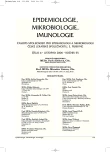Nontuberculous Mycobacteria and Incidence of Mycobacterioses in Prague in 1999–2004
Authors:
V. Polanecký 1; P. Kalina 1; M. Kubín 1; B. Kozáková 2; M. Müllerová 3
Authors‘ workplace:
Hygienická stanice hl. m. Prahy
1; Zdravotní ústav se sídlem v Praze
2; KLINLAB, s. r. o.
3
Published in:
Epidemiol. Mikrobiol. Imunol. 55, 2006, č. 4, s. 151-157
Overview
Objective:
To analyze the incidence of nontuberculous mycobacteria detected in Prague patients in 1999–2004 as either single findings suggestive of clinical insignificance or repetitive findings suggestive of mycobacteriosis when reported together with the corresponding organ damage and symptomatology.
Material and methods:
Nontuberculous mycobacteria were isolated and identified according to the Czech recommended methods for mycobacterial diagnosis in two Prague laboratories. The determined incidence rates of Mycobacterium (M.) kansasii, M. avium complex (MAC) and M. xenopi were compared with the respective nationwide rates and those of other nontuberculous bacteria, M. tuberculosis and M. bovis. The data on cases of mycobacterioses reported within the Czech Registry of Tuberculosis were provided by the Institute of Health Information and Statistics of the Czech Republic.
Results:
In 1999–2004, the annual incidence rates of nontuberculous mycobacteria detected in Prague patients ranged between 169–139 and accounted for 13–25% of the totals of isolated jedmycobacteria including M. tuberculosis and M. bovis. Over this period, M. kansasii, MAC and M. xenopi were detected in 45, 76 and 43 patients, respectively. The single to repetitive detection ratio was the highest for M. kansasii (1:1.6), followed by MAC (1:1.8) and M. xenopi (1:2.3). Most male excretors were from higher age categories (median of 58–73 years) while the median age of female excretors ranged between 41 and 75 years. As many as 47 cases of mycobacterioses caused by the following agents: M. kansasii (20 cases), MAC (17 cases), M. xenopi (6 cases) and other nontuberculous mycobacteria (4 cases), were reported to the National Registry of Tuberculosis over the study period.
Conclusions:
Detection and identification of nontuberculous mycobacteria have become part of diagnostic routine of mycobacteriological laboratories. Compared to conventional tuberculous mycobacteria, detection of nontuberculous mycobacteria often requires the use of different and more cumbersome procedures such as incubation at preferential temperatures, longer incubation for detection of growth in primary cultures, species specific culture media, etc.. More skills and experience are needed for the use of automated detection systems and molecular biological techniques for species identification and interpretation of results. Regular consultations with clinical and outpatient physicians are crucial for the assessment of pathogenetic potential of nontuberculous mycobacteria.
Key words:
mycobacteriosis – nontuberculous mycobacteria – Mycobacterium avium – Mycobacterium kansasii – Mycobacterium xenopi.
Labels
Hygiene and epidemiology Medical virology Clinical microbiologyArticle was published in
Epidemiology, Microbiology, Immunology

2006 Issue 4
Most read in this issue
- Mumps – a Reemerging Infection? The Current Incidence of Mumps in the East Bohemian Region in the Czech Republic
- Microbiology Online – Interactive Learning and a New Discussion Forum for Microbiology Teachers
- Nontuberculous Mycobacteria and Incidence of Mycobacterioses in Prague in 1999–2004
- Prevalence of Hepatitis G Virus (HGV) in Intravenous Immunoglobulin Recipients in the Czech Republic
